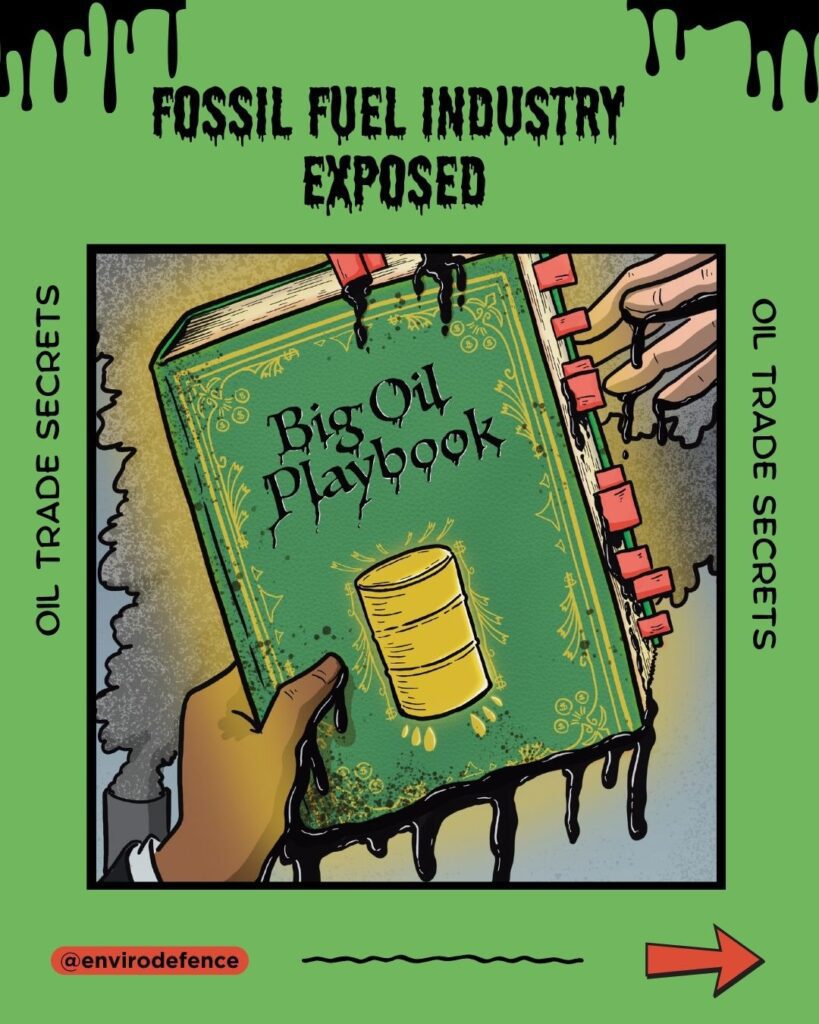We’ve uncovered the strategies Big Oil relies on to protect its profits and delay climate action. The fossil fuel industry’s tactics have influenced governments, misled the public, and stalled real solutions to address the climate crisis.
Our goal is to paint a clear picture of how oil and gas companies operate, how they generate support for the industry, and leverage it against effective climate solutions. Some of their tactics, like greenwashing and lobbying, have been well-publicized. Yet others have been largely hidden from the public, like funding astroturf groups, supporting anti-renewable energy campaigns, and infiltrating educational institutions. Many of the tactics are designed to create “social license” for the industry. This means convincing the public to accept harmful corporate activities by framing them as reasonable and necessary despite their environmental and social costs. In order to gain or maintain this social license, corporate actors will get communities to depend on them for programs and services, shape public perception and influence media narratives, or try to compensate with other good corporate behaviour.
Many of the tactics are designed to create “social license” for the industry. This means convincing the public to accept harmful corporate activities by framing them as reasonable and necessary despite their environmental and social costs. In order to gain or maintain this social license, corporate actors will get communities to depend on them for programs and services, shape public perception and influence media narratives, or try to compensate with other good corporate behaviour.
For example, during the peak of the youth-led climate strikes, the climate movement was politically powerful, concern about climate change was high and it was ranked a top priority for voters. It was strategically imperative at this time that the fossil fuel industry maintain social license by appealing to those climate concerns. So Big Oil did a strategic rebrand.
Major tar sands companies created a new front group called the Pathways Alliance, pitched a carbon capture and storage project – a noted false-solution for industry’s climate pollution, ran huge advertising campaigns on “working towards net-zero” (which were stopped once the federal government’s anti-greenwashing rules came into effect). All the while the fossil fuel industry continued fighting the government’s climate plans and emissions reduction policies. Big Oil was convincing the public and governments that they too were “climate-concerned” at a time when public pressure for government climate action was mounting, in order to fend off the pressure for more ambitious regulations on their pollution. These efforts to maintain the social license of fossil fuel production in Canada also created a misleading myth that fossil fuel extraction could continue, and even increase, without perilous long-term consequences for the climate, society and economy.
But the climate science is clear. Fossil fuels are driving the climate crisis and triggering biodiversity and ecosystem collapse. To prevent extreme and life-threatening global heating, production and use of coal, oil, and gas must decline as rapidly as possible, and to do so fairly, we should plan for and actively manage that decline. Demand for coal, oil, and gas is projected to peak in under five years, and the transition to renewable energy is rapidly accelerating. We have the tools to move forward and away from fossil fuels, but Big Oil is deploying all its strategies to fight against that change and keep profiting from fossil fuels.
Join us as we explore ten of Big Oil’s tactics this fall, and reveal the full illustrated playbook
Tactic 1: The Everywhere Advertisements & Greenwashing
The tactic: Fossil fuel companies run advertising campaigns that include traditional media advertising (online news, television, radio, print and public ad space), social media (professionally produced ad paid placements, influencers, and astroturf pages), and also sponsorships of events, athletes, and other high-profile figures. Advertising campaigns range from disinformation and climate denial to greenwashing, to vague pro-fossil fuel ads that manipulate emotions in favour of fossil fuels or tie identity markers to a pro-fossil fuel lifestyle. Fossil fuel industry advertisements rarely show their products directly, but more often promote the images and values they hope to associate with their brand, or other implicit pro-fossil fuel narratives. For example, they may show a car with a family getting groceries, life-stage milestones, or nature to evoke a sense of pride and relatability. Another trend in fossil fuel advertising that researchers have identified is efforts to tie oil and gas, and pro-fossil fuel attitudes, to masculinity.
The strategy: Advertising campaigns and repeated messaging are effective at subconsciously and consciously shaping perspectives. Advertising creates pro-fossil fuel narratives and a positive general impression that helps maintain social license.
Where you’ve seen it before: Advertising is everywhere. While it’s difficult to say exactly how much Big Oil spends on advertising, one investigation found that the five biggest oil companies in the world (ExxonMobil, BP-Amoco, Chevron-Texaco, Royal Dutch Shell and ConocoPhillips) collectively spent an average of US$217 million on advertising annually between 2008-2016, a sixfold increase from two decades earlier, according to a 2019 paper in the journal Climatic Change.
Pathways Alliance Greenwashing
Notable misleading advertisements include the Pathways Alliance “Let’s Clear The Air” ad series, which was called out as greenwashing by journalists and academic researchers. This ad campaign blanketed radio waves and Spotify, covered public transit, played on commercial flights, and ran during the FIFA World Cup, Australian Open, and 2023 Super Bowl. There were full-page print newspaper ads, digital news media rollout and over a million dollars spent on Facebook and Instagram promotion. Then, when the federal government’s anti-greenwashing rules came into effect, Pathways Alliance took it all down. A greenwashing complaint was filed with the Competition Bureau against Pathways, but the company was never required to correct the record. So, we at Environmental Defence did it for them – check out our video spoofing their ad and setting the record straight on carbon capture Clean Pathway to Future – (Official Video)
Fossil gas gets a glow-up: now branded as “natural”
In the digital age, fossil fuel companies have embraced using influencers to try reaching younger audiences. Gas associations in particular have run extensive influencer campaigns to promote cooking with gas stoves. A greenwashing complaint was filed against the Canadian Gas Association for its promotion of “natural” gas, which gave misleading information about the costs and environmental impact. The complaint, submitted by the Canadian Association of Physicians for the Environment, points out that gas stoves have been shown to increase the risk of asthma in children, and that the production of natural gas, a fossil fuel, in fact causes air and water pollution.
Companies spend millions on advertising because they know it can work. Misleading or concerning fossil fuel advertisements can be reported to Ad Standards Canada and greenwashing complaints can be filed with the Competition Bureau. But beyond the most egregious examples of greenwashing, general advertising that promotes fossil fuels is still a powerful tactic used by fossil fuel companies to influence the public in support of their industry.











